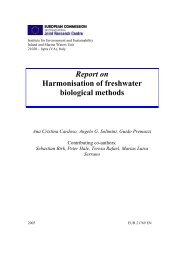Lakes and Watercourses
Lakes and Watercourses
Lakes and Watercourses
Create successful ePaper yourself
Turn your PDF publications into a flip-book with our unique Google optimized e-Paper software.
The pre-industrial concentration of sulphate (SO 4 * o ) in the majority of<br />
acidified waters or waters sensitive to acidification can safely be set at<br />
zero, in which case the alkalinity ratio <strong>and</strong> deviation classification will<br />
depend solely on present alkalinity <strong>and</strong> sulphate concentration. This<br />
means that the deviation class (acidification class) can be identified<br />
directly from Figure 2.<br />
Comments<br />
Classifications must be based on samples taken <strong>and</strong> analyses made in<br />
accordance with the Swedish EPA Environmental Monitoring H<strong>and</strong>book.<br />
The assessments should be based on data from at least 12 samples<br />
taken either monthly over one year, every other month over two years or<br />
quarterly over three years (see Environmental Monitoring H<strong>and</strong>book –<br />
water chemistry of lakes <strong>and</strong> water chemistry of watercourses). The<br />
calculations <strong>and</strong> classifications described above are intended to refer to<br />
the median values of the relevant parameters during the sampling period.<br />
If assessments are made on the basis of single samples, such as<br />
synoptic studies, this should be stated. If so, samples must have been<br />
taken at a time of year when the acidity of the water is reasonably stable.<br />
The class boundaries given for assessing current conditions take<br />
account of the fact that lakes <strong>and</strong> running waters can be appreciably<br />
more acidic for a short time during the spring flood than during the rest<br />
of the year. However, ”acidic surges” during the spring flood may cause<br />
pronounced biological effects in waters (principally streams), even<br />
though buffering capacity is fairly or even very good at other times of<br />
year. In such cases, relevant assessments of the acidity of such watercourses<br />
require study of both biological parameters <strong>and</strong> water chemistry.<br />
References<br />
Bernes, C. (1991): Acidification <strong>and</strong> liming of Swedish lakes <strong>and</strong> watercourses.<br />
Monitor 12, Swedish EPA.<br />
Wil<strong>and</strong>er, A. (1998): Surhet/försurning (”Acidity/acidification”). – From: T.<br />
Wiederholm (Ed.). Bedömningsgrunder för miljökvalitet – Sjöar och vattendrag.<br />
Bakgrundsrapport 1 – Kemiska och fysikaliska parametrar (”Environmental Quality<br />
Criteria – <strong>Lakes</strong> <strong>and</strong> <strong>Watercourses</strong>. Background report 1 – Chemical <strong>and</strong> physical<br />
parameters”). Swedish EPA Report 4920. In Swedish with English summary.<br />
40















![Accommodation booking form [PDF]](https://img.yumpu.com/39471785/1/184x260/accommodation-booking-form-pdf.jpg?quality=85)

